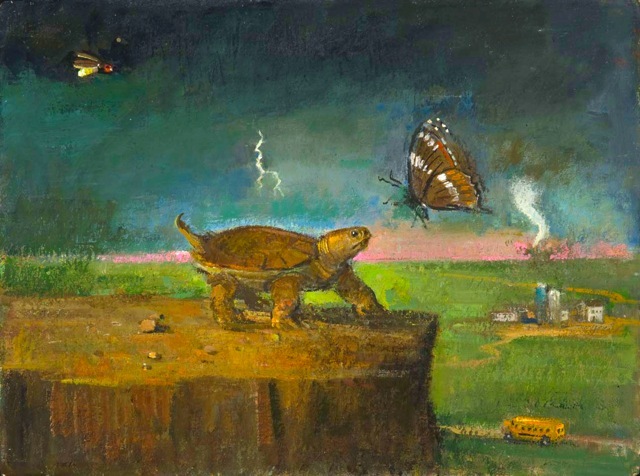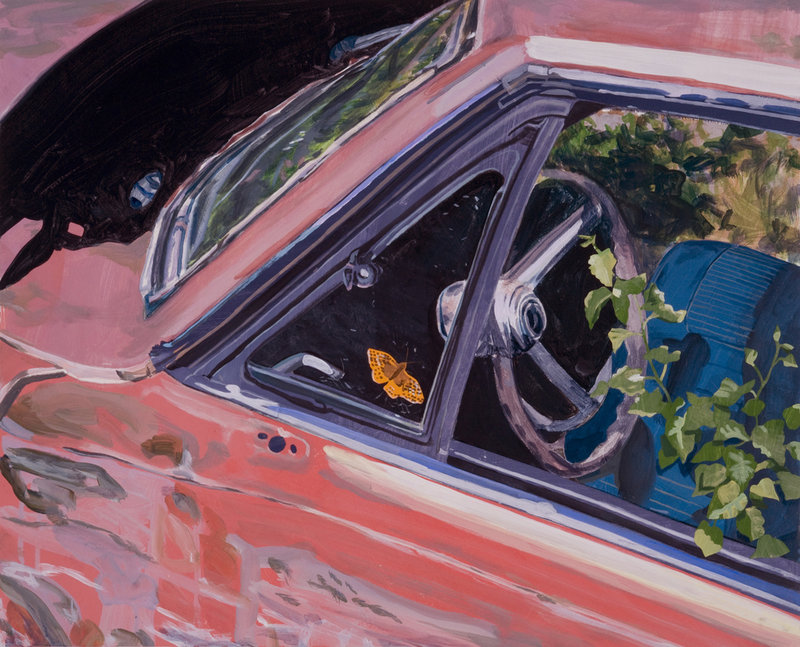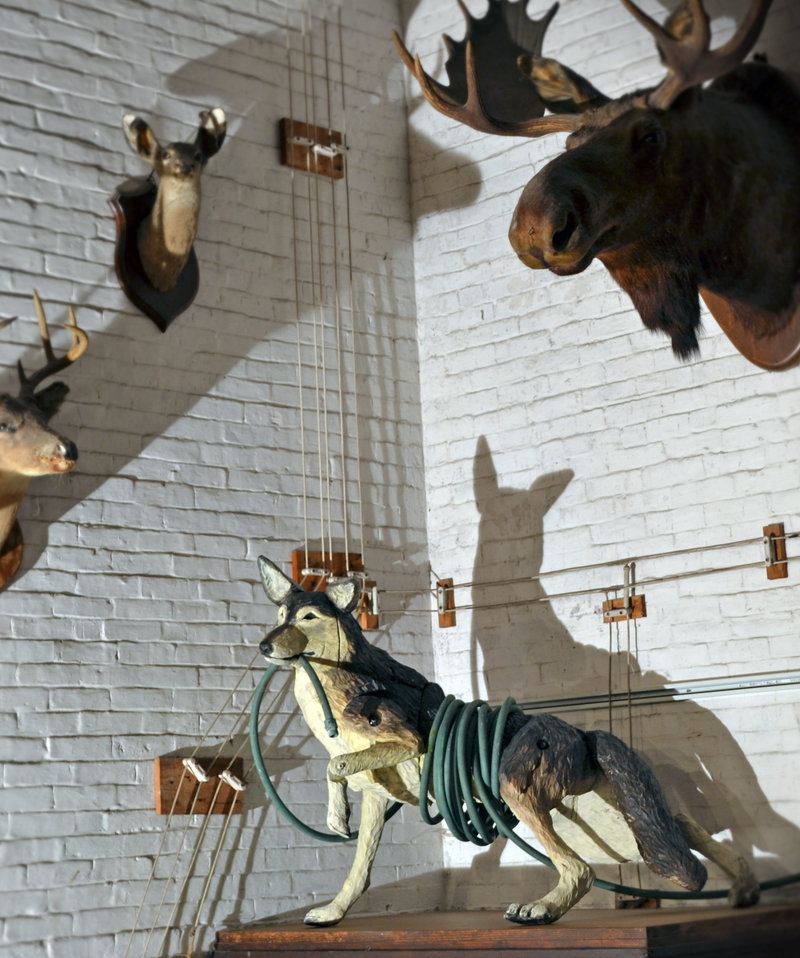I think Romanticism and the Victorian era are wildly misunderstood by virtually all Americans.
This isn’t some broadside about how ignorant Americans are; rather, I think our culture has deluded itself over generations so that we now believe we are more about the settled knowledge of empirical science than about discovery, exploration, personal experience and invention.
Our culture is all about Romanticism. We are addicted to boldly going where no one has gone before. We don’t see ourselves as the prim and industrious New Englanders Ben Franklin’s maxims admonished us to be. No, we want to be Ben Franklins: Inventive entrepreneurs, witty partiers and charismatic revolutionaries.
Abstract Expressionism is the operating model for American art. And it’s all about the individual and his struggle to find new means by which to express himself heroically through his medium on some grand scale.
“Humanity in Nature” is an exhibition over-determined to address some of these issues, but all the more so because it is at Maine’s great Victorian institution, the L.C. Bates Museum in Hinckley.
Instead of a group of works neatly hung in a measured line in some white box gallery, the show is interspersed among the dizzying, varied and quirky holdings of the museum: Marble busts, painted dioramas with taxidermy animals, scores of glass cases containing everything from fossils and minerals to tools and historical documents, and so on. Every inch of the unrelentingly Victorian 1888 building seems to be occupied by artifact, art or information.
Personally, I love this quiet cacophony of quirky over-indulgence. It’s one mysteriously intriguing surprise after another. If you have never been to the L.C. Bates Museum, you are missing one of Maine’s most magical places. It’s like visiting a gothic novel.
I have seen art shows there, but never one that seemed to exhume the museum’s tell-tale heart quite like “Humanity in Nature.”
It’s hardly a perfect show, and it’s a little too dense in numbers even for a salon-style enthusiast like me, but there are at least a dozen phenomenal pieces in the coherently strong show that feels like a treasure-hunt at its wonder-cabinet edges.
The label of Michael Droge’s mysteriously titled “Conjuring Homer 5am” reads: “My work draws from experiences that are overwhelmingly excessive and unspeakable.”
I laughed out loud when I read the statement, because it’s basically a dictionary definition of the sublime. The painting is a misty dawn seascape in black and white. It’s huge and dreamy but intense — the Frankensteinian title notwithstanding.
It’s a great painting that could hardly be more perfect for the museum and the show except for the fact that Chris Augusta’s uber-creepy “Malarial Dreams” hangs just a few feet away.
Augusta is a Maine artist whose work has been inspired by travels in South America. It’s the kind of irrational worldliness at the core of the Romantic explorer mentality on which the museum is founded.
Yet neither of these paintings has the ironic insight of Veronica Cross’ “Caught,” in which a dead moth is suspended in a spider web in an old car abandoned in an overgrown field.
Surrounded by vitrines displaying dead animals, Cross’ work questions the ephemeral nature of life as well as the landscapes of nature and human culture. It’s as though they will always die in each others’ arms for unawakened eternities.
One of the most subtle pieces to double back on the power of the L.C. Bates Museum is Michael Branca’s “It Grew That Way.” The piece is little more than a section of a maple tree root that assimilated a piece of iron and some plastic as it grew around them.
In the context of the natural oddities surrounding it, the piece questions the frontiers between naturalist artifact and art — while conjuring memories of any weird thing you ever found that struck you as somehow twistedly notable.
Andy Rosen’s “The Gardener” is set as a bit of a surprise to any unsuspecting visitor. In a room filled with taxidermy treasures, he presents a life-size wolf with a garden hose unnaturally wrapped around its middle.
In a melodramatic pose and placed as it is, the details such as the hinged leg are key for recognizing the ironic wit that drives it. In this quirky circus, Rosen’s sculpture could easily be overlooked — and that’s amazing.
Nancy Morgan Barnes’ painting “An Amoral Fable” shows its Romantic nature with gothic alacrity. In this show, fairytales feel more grim than gay. A siren butterfly seems to be getting the best of her slow and steady suitor — mesmerized in flirtatious frolic — at the cliff’s edge in a storm-inflicted dark industrial landscape.
While Stephen Burt’s “Terrible Beauties” is a Conte crayon drawing, it’s rendered in an engraving style that we associate with the ancient knowledge contained in old prints, maps and diagrams, when the unknown was delineated by the phrase “here be dragons.”
In his densely intense style, Burt presents a nightmarish pair of fantastical giants — a sea serpent and a giant alligator — battling in a Pacific landscape inspired by Japanese woodblock prints.
The element of humanity that Burt, Augusta, Droge and others present is our Romantic imagination regarding nature. Another approach is typified by Nina Bohlen’s showing us human detritus in her “Downstream” paintings with a straightforwardly moralistic shake of the finger.
But the pieces geared towards the outer edges of human imagination truly get their due in “Humanity in Nature,” because mystery and awe are not just tolerated but celebrated.
The dioramas designed and gorgeously painted by American Impressionist Charles Daniel Hubbard (1876-1951) alone make a trip to the L.C. Bates Museum worth the trip any time.
But with “Humanity in Nature” as a stepping stone, all that Romantic/gothic/Victorian stuff suddenly doesn’t seem so weird or so distant from what we are now.
Freelance writer Daniel Kany is an art historian who lives in Cumberland. He can be contacted at:
dankany@gmail.com
Send questions/comments to the editors.






Comments are no longer available on this story